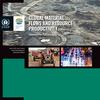Similar presentations:
Agriculture in Argentina
1. Agriculture in Argentina
2.
Agriculture is one of the bases of Argentina's economy.One fourth of Argentine exports of about US$86 billion
in 2011 were composed of unprocessed agricultural
primary goods, mainly soybeans, wheat and maize. A
further one third were composed of processed
agricultural products, such as animal feed, flour and
vegetable oils. The national governmental organization
in charge of overseeing agriculture is the Secretariat of
Agriculture, Cattle Farming, Fishing and Food (Secretaría
de Agricultura, Ganadería, Pesca y Alimentos, SAGPyA).
3.
The need for intensive agriculture was recognized as early as1776. Aside from the yerba mate harvest in the northeast,
attempts to develop it suffered setbacks due to internal strife
and lack of skill and machinery. The development of a cohesive
state after 1852 led to the 1868 creation of Argentina's first
Institute of Agronomy and the 1875 arrival of the first intact
grain shipment from Argentina to Great Britain sparked a wave
of local investment in cultivation and silos and British investment
in railways and finance.
Domestic austerity policies pursued by the last dictatorship and
Raúl Alfonsín's government led to record trade surpluses during
much of the 1976–90 era, led by agricultural exports and,
notably, the sudden boom in soybean cultivation, which
displaced sunflower seeds as the leading oilseed crop in 1977. A
severe shortage of domestic credit hampered the sector
somewhat, however, as growing harvests soon outstripped
transport and storage capacity
4.
CerealsOne of the main exports of the country are cereals,
centered on corn, wheat and sorghum, with rice and
barley produced mainly for national consumption. With
a total area of around 220.000 km², the annual
production of cereals is around 100 million tonnes.
5.
FruitGrapes (mostly for the wine harvest), together with lemons, apples and pears
are the most important fruit harvests, produced mainly in the Río Negro
valleys of Río Negro Province and Neuquén Province, as well as Mendoza
Province. Other important crops include peaches and other citruses. With an
area of around 6.000 km², the fruit production is around 18 million annual
tonnes.
The value of Argentine wine production reached 3.4 billion USD in 2011, of
which 40% was exported.























 economics
economics








